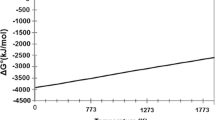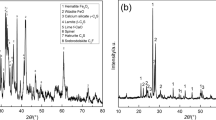Abstract
Removal of oxides on the surface of flat steels with hydrochloric acid before galvanising is a common process in steel manufacturing. During this process, a significant amount of iron ions accumulates in the spent acid solution. Recovery of metals and acids from pickling solutions is essential for environmental protection and the economy. Therefore, different techniques are developed for acid and metal recovery from spent pickling solutions. Spray roasting is one of the most widely used techniques for the recovery of HCl from pickling solutions. In this process, while HCl is recovered by evaporation, iron is obtained as iron oxide (FexOy) granules. In this study, the production of iron boride (Fe2B) from high purity iron oxide produced as pickling waste was investigated. Single-phase nanocrystalline Fe2B production by a one-step carbothermic reduction process using waste FexOy and diboron trioxide (B2O3) has been carried out for the first time. The effect of temperature (1273–1473 K) and time (30–270 min) on Fe2B production at constant stoichiometric weight ratios of FexOy/B2O3/C = 3.47/1.56/1.53 was investigated. The produced particles were characterized using X-ray diffraction (XRD), scanning electron microscopy (SEM), and a vibrating sample magnetometer (VSM). XRD results showed that synthesis temperature and duration primarily control Fe2B formation. Fe2B particles with a crystalline size of 39 nm were successfully produced at 1473 K and 270 min. The saturation magnetization, permanent magnetization, and coercivity values of the produced nanocrystalline alloy were determined as 137 emu/g, 22.51 Oe, and 0.812 emu/g, respectively.
Graphical Abstract












Similar content being viewed by others
References
Zheng GH, Kozinski JA (1996) Solid waste remediation in the metallurgical industry: application and environmental impact. Environ Prog 15:283–292. https://doi.org/10.1002/ep.670150419
Iluţiu-Varvara DA, Aciu C (2022) Metallurgical wastes as resources for sustainability of the steel industry. Sustain 14(9):5488–5513. https://doi.org/10.3390/su14095488
Jursová S (2010) Metallurgical waste and possibilities of its processing. Met 2010 - 19th Int Conf Metall Mater Conf Proc, 115–120, Rožnov pod Radhoštěm, Česká Republika
Matinde E, Simate GS, Ndlovu S (2018) Mining and metallurgical wastes: a review of recycling and re-use practices. J South African Inst Min Metall 118:825–844. https://doi.org/10.17159/2411-9717/2018/v118n8a5
Kuklık V, Kudlacek J (2016) Hot-dip galvanizing of steel structures. Elsevier, Amsterdam
Regel-Rosocka M (2010) A review on methods of regeneration of spent pickling solutions from steel processing. J Hazard Mater 177:57–69. https://doi.org/10.1016/j.jhazmat.2009.12.043
Lorenz M, Seitfudem G, Randazzo S et al (2023) Combining membrane and zero brine technologies in waste acid treatment for a circular economy in the hot-dip galvanizing industry: a life cycle perspective. J Sustain Metall. https://doi.org/10.1007/s40831-023-00668-3
Schiemann M, Wirtz S, Scherer V, Bärhold F (2012) Spray roasting of iron chloride FeCl2: laboratory scale experiments and a model for numerical simulation. Powder Technol 228:301–308. https://doi.org/10.1016/j.powtec.2012.05.037
Harris LJF (1994) Introduction to spray roasting process for hydrochloric acid regeneration and its application to mineral processing. Hydrometall 94:923–937. https://doi.org/10.1007/978-94-011-1214-7_62
Regel-Rosocka M, Cieszynska A, Wisniewski M (2007) Methods of regeneration of spent pickling solutions from steel treatment plants. Polish J Chem Technol 9:42–45. https://doi.org/10.2478/v10026-007-0023-x
Gueccia R, Winter D, Randazzo S et al (2021) An integrated approach for the HCl and metals recovery from waste pickling solutions: pilot plant and design operations. Chem Eng Res Des 168:383–396. https://doi.org/10.1016/j.cherd.2021.02.016
Ozdemir I, Ogawa K, Sato K (2014) Iron boron based powders sprayed by high velocity spray processes. Surf Coatings Technol 240:373–379. https://doi.org/10.1016/j.surfcoat.2013.12.056
Oğuz A (2016) Fluidized bed design suitable for reduction with hydrogen and metallic iron production from steel pickling waste. MD Thesis, Istanbul Technical University, Istanbul
Zhao Q, Li W, Liu C et al (2022) Preparation of anode material of lithium–ion battery by spent pickling liquor. J Sustain Metall 9:148–159. https://doi.org/10.1007/s40831-022-00638-1
Abenojar J, Velasco F, Mota JM, Martínez MA (2004) Preparation of Fe/B powders by mechanical alloying. J Solid State Chem 177:382–388. https://doi.org/10.1016/j.jssc.2003.01.001
Wang D, Ma L, Li L et al (2018) Characterization of polycrystalline Fe2B compound with high saturation magnetization. J Supercond Nov Magn 31:431–435. https://doi.org/10.1007/s10948-017-4233-z
Wei Y, Liu Z, Ran S et al (2017) Synthesis and properties of Fe–B powders by molten salt method. J Mater Res 32:883–889. https://doi.org/10.1557/jmr.2017.38
Kartal L, Daryal MB, Timur S (2020) A new approach for Cu and Fe/FexB production from chalcopyrite by molten salt electrolysis. J Sustain Metall 6:751–760. https://doi.org/10.1007/s40831-020-00312-4
Kartal L (2022) Single Fe2B phase particle production by calciothermic reduction in molten salt. Hittite J Sci Eng 9:145–150. https://doi.org/10.17350/HJSE19030000
Sireli GK (2016) Molten salt baths: electrochemical boriding. In: Colás R, Totten GE (eds) Encyclopedia of iron, steel, and their alloys, 1st edn. Taylor and Francis, Wales, pp 2284–2300
Simsek T, Baris M, Kalkan B (2017) Mechanochemical processing and microstructural characterization of pure Fe2B nanocrystals. Adv Powder Technol 28:3056–3062. https://doi.org/10.1016/j.apt.2017.09.017
Mertdinç S, Ağaoğulları D, Öveçoğlu ML (2018) Mechanochemically synthesized Fe2B nanoparticles embedded in SiO2 nanospheres. Ceram Int 44:14834–14843. https://doi.org/10.1016/j.ceramint.2018.05.116
Mohammadi M, Ghasemi A, Tavoosi M (2016) Mechanochemical synthesis of nanocrystalline Fe and Fe–B magnetic alloys. J Magn Magn Mater 419:189–197. https://doi.org/10.1016/j.jmmm.2016.06.037
Yücel O, Cinar F, Addemir O, Tekin A (1996) The preparation of ferroboron and ferrovanadium by Aluminothermic reduction. High Temp Mater Process 15:103–109. https://doi.org/10.1515/HTMP.1996.15.1-2.103
Verma PC, Mishra SK (2019) Synthesis of iron boride powder by carbothermic reduction method. Mater Today Proc 28:902–906. https://doi.org/10.1016/j.matpr.2019.12.321
Barış M, Şimşek T, Taşkaya H (2018) Synthesis of Fe–Fe2B catalysts via solvothermal route for hydrogen generation by hydrolysis of NaBH4. J Boron 3:51–62. https://doi.org/10.30728/boron.348291
Cheng Y, Choi S, Watanabe T (2013) Effect of nucleation temperature and heat transfer on synthesis of Ti and Fe boride nanoparticles in RF thermal plasmas. Powder Technol 246:210–217. https://doi.org/10.1016/j.powtec.2013.05.028
Zakharov G, Aslamazashvili Z, Chikhradze M et al (2021) production of ferroboron from wastes by shs-metallurgy and influence of ligatures on the structure/properties of cast iron. IOP Conf Ser Earth Environ Sci. https://doi.org/10.1088/1755-1315/906/1/012008
Şimşek T, Avar B, Şimşek T et al (2021) A single step synthesis by mechanical alloying and characterization of nanostructured Fe2B of high magnetic moment. Ceram Int 47:26119–26124. https://doi.org/10.1016/j.ceramint.2021.06.018
Ross JRH (2019) Catalyst Characterization. In: Ross JRH (ed) Contemporary catalysis fundamentals and current applications. Elsevier, Amsterdam, pp 121–132
Yucel O, Addemir O, Tekin A (1992) the optimization of parameters for the carbothermic production of ferroboron. Infacon 6(1):285–289
Arslan M, Ok AC, Kartal Sireli G, Timur S (2022) Investigation on structural and tribological properties of borided gear steel after phase homogenization. Surf Coatings Technol 429:1–14. https://doi.org/10.1016/j.surfcoat.2021.127967
Kartal G, Eryilmaz OL, Krumdick G et al (2011) Kinetics of electrochemical boriding of low carbon steel. Appl Surf Sci 257:6928–6934. https://doi.org/10.1016/j.apsusc.2011.03.034
Author information
Authors and Affiliations
Corresponding author
Ethics declarations
Conflict of interest
The author declares no conflict of interest.
Additional information
The contributing editor for this article was Yongxiang Yang.
Publisher's Note
Springer Nature remains neutral with regard to jurisdictional claims in published maps and institutional affiliations.
Rights and permissions
Springer Nature or its licensor (e.g. a society or other partner) holds exclusive rights to this article under a publishing agreement with the author(s) or other rightsholder(s); author self-archiving of the accepted manuscript version of this article is solely governed by the terms of such publishing agreement and applicable law.
About this article
Cite this article
Kartal, L. Singe Phase Iron Boride (Fe2B) Particle Production from Pickling Wastes by One Step Carbothermic Reduction. J. Sustain. Metall. 9, 1660–1669 (2023). https://doi.org/10.1007/s40831-023-00755-5
Received:
Accepted:
Published:
Issue Date:
DOI: https://doi.org/10.1007/s40831-023-00755-5




